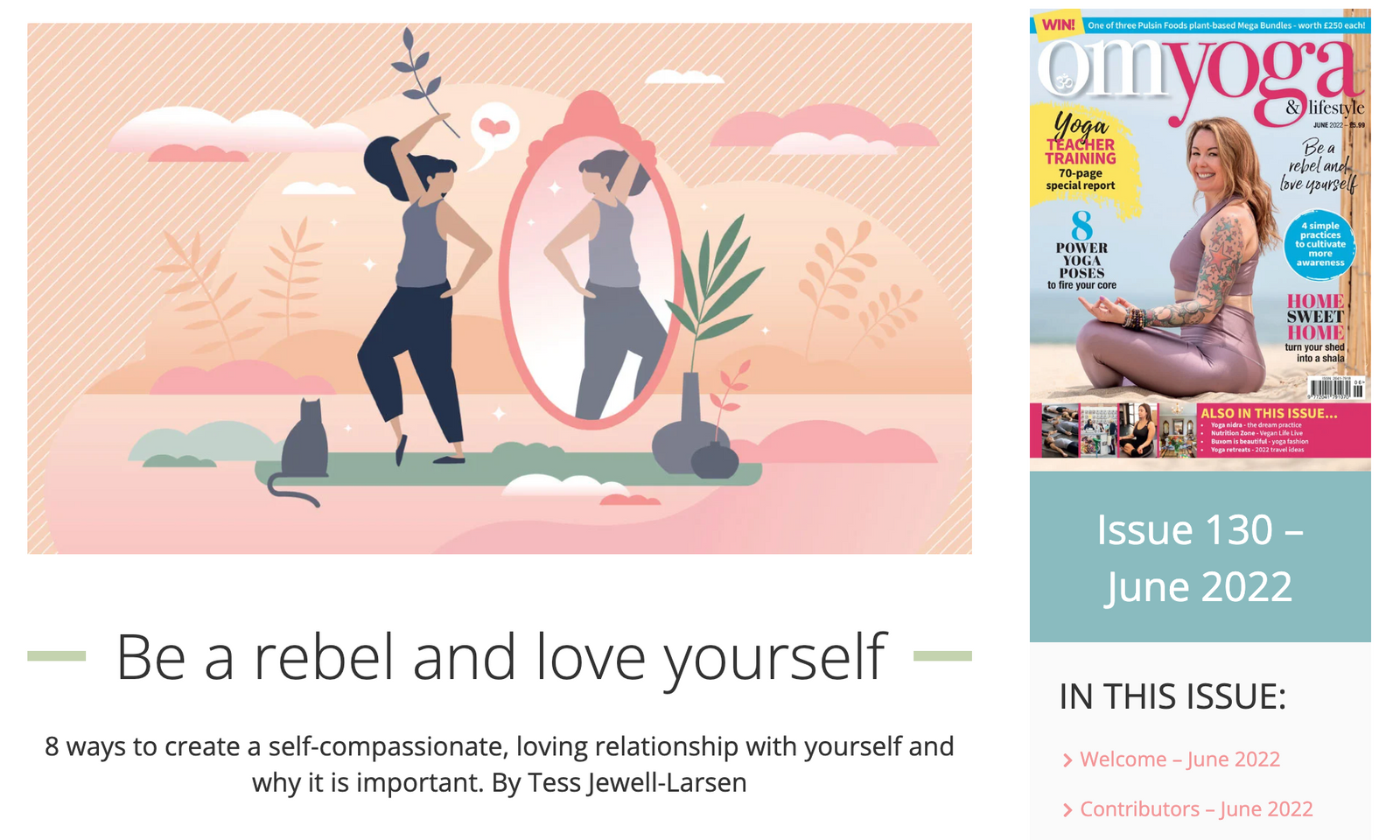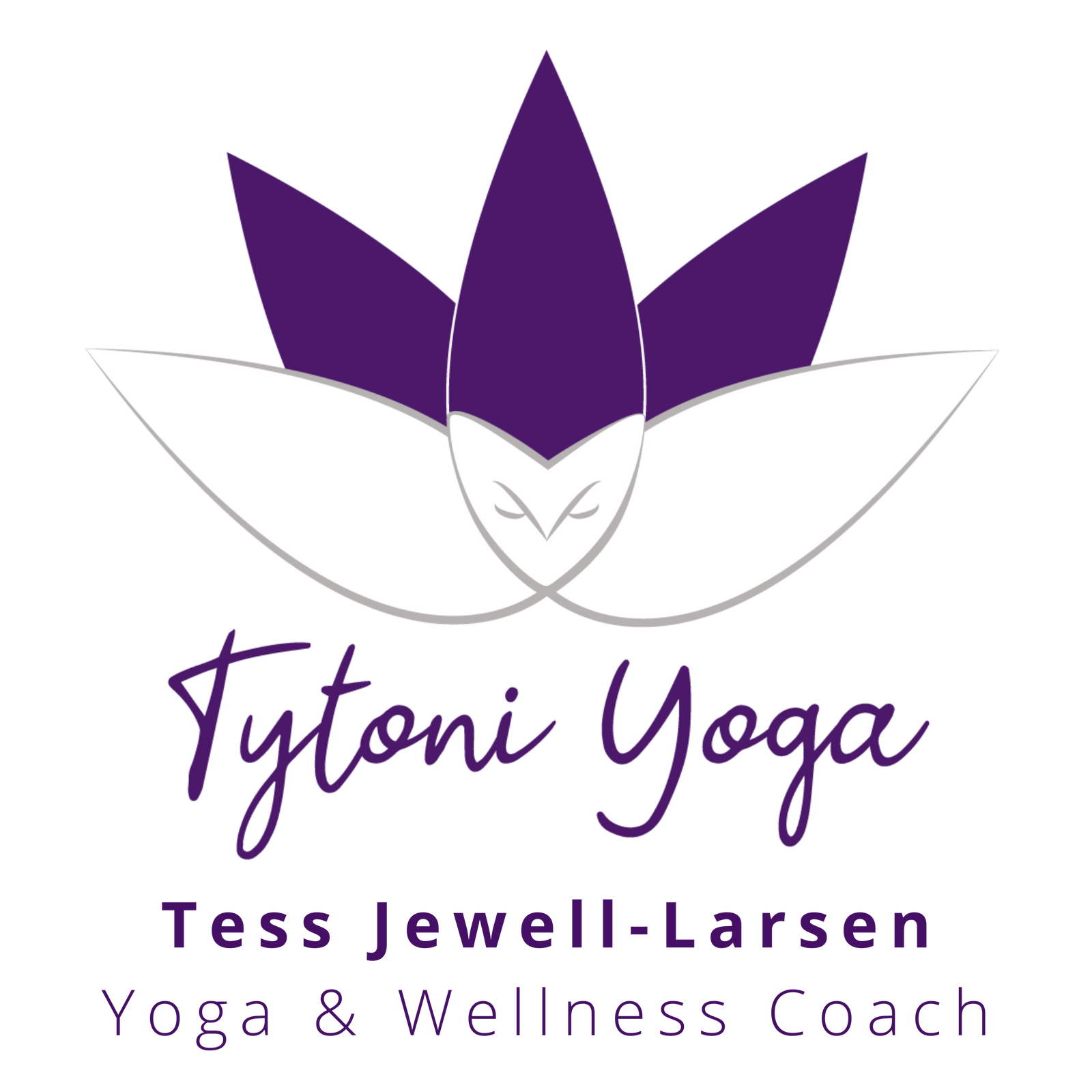The 4 Breathing Exercises behind “Be a Rebel and Love Yourself”
Tess Jewell-Larsen | MAY 19, 2022

In my article, Be a Rebel and Love Yourself, in the June 2022 issue of OM Yoga & Lifestyle Magazine, I talked about 8 ways we can love ourself and why it’s important. I’ve gotten a lot of great feedback (thank you!) but one thing that has come up a few times is people wanting to learn how to do some of the tools I suggest (especially the breathing techniques).
First, let’s go through the 8 suggestions I give:
- Compassionate self-communication
- Mindful breathing
- Mindful movement
- Meditation
- Creating healthy habits
- Do what you love to do
- Celebrate wins and forgive mistakes
- Pace and give grace
I’m not going to go through them all in depth, you can go read the article for that. But I do want to pinpoint certain techniques I mention and how to go about doing them.
In the article, I mention 4 different breathing techniques that can help us create a connection with ourselves, release tension, and send signals to our brain brain to say, I’m okay. So let’s go through them!
Stair Step Breath
Stair Step Breath is a great breathing exercise to help us when we’re feeling anxious and overwhelmed, and our breath is extremely shallow and tight chested.
- Before you begin—check in with yourself. Observe what comes up without judgement.
- Imagine you are walking up a mountain.* Take 5 sips of breath, one on top of the other. For a brief moment, hold your breath and imagine you’re at the top of the mountain, what can you see? Then imagine you can slide safely down the other side of the mountain, releasing your breath in one long, easy stream. Do this a 3-4 more times.
- Imagine you can ride a gondola up the mountain. Take a long, easy breath up. For a brief moment, hold your breath and imagine you’re at the top of the mountain, what can you see? And then imagine yourself walking down the mountain, slowly releasing the breaths out in 8-10 short, gentle bursts of breath. Do this 3-4 more times.
- Imagine you are walking up and down the mountain. 5 steps/sips of breath up. For a brief moment, hold your breath and imagine you’re at the top of the mountain, what can you see? 8-10 steps/gentle bursts of breath down. Do this 3-4 more times.
- Repeat instructions from #1 again.
- Now take an easy breath in and a long breath out. Imagining you are riding the gondola up and sliding safely down the mountain. Do this 3-4 more times.
- Check in with yourself again. How do you feel now?
*If you have a heart problem, you a pregnant, or for any other reason you know you shouldn’t be holding your breath, cut out the hold.
4x8 Breathing
4x8 Breathing is wonderful breathing exercise to help us when we’re feeling stressed. It’s a type of paced breathing, or counting while we breathe. In this case, breathing in on a count of 4, exhaling to a count of 8.
The idea is to breathe in to a certain count and exhale to a longer count. When our exhale is longer than our inhale, this triggers signals that are sent to our brain, telling the brain that the body isn’t in danger and we can come out of a sympathetic response, or a fight or flight response.
Sometimes, though counting 4 in and 8 out, isn’t the best entry point. Depending on how you are feeling, you may want to start at a lower level count. For example: breathing in 3, exhaling 6. And then slowly building up, as you feel comfortable doing so in your body. And perhaps, once you get to 4x8, you may want to keep extending it. Maybe going to 5x10, 6x12, etc. But only if it feels comfortable doing it, do not strain yourself. It is not a competition. It’s about listening to your body and working with it where it’s at. LOVING yourself enough to acknowledge your limitations in that moment without judgement.
Alternate-nostril breathing (Anulom Vilom)
Alternate-nostril breathing, or Anulom Vilom, is great exercise to increase patience, focus, and control. It helps balance the nervous system and relieve stress and anxiety. It also improves respiratory systems and cardiovascular health.
In essence you breathe in through one nostril (starting on the left) and exhale out the other side. Inhaling back in through the same side that you just exhaled from and then exhale out through the first nostril. You can do this either with your fingers gently blocking on nostril at a time. One way to do this is making a “hang loose” 🤙 gesture with your right hand, putting your right thumb to the right nostril and your pinky to your left nostril. Another way is without the physical blocking and instead shifting your focus the air coming in through one nostril and then to the other (I especially recommend to do it without hands if you are pregnant, congested or it feels un comfortable for you to block nostrils.)
By going back and forth, this helps regulate and balance the brain and in turn stress hormones being released into the body.
I don’t currently have a video up on YouTube for this exercise, but you can find it in my online studio membership in the Yoga Foundations section: Anulom Vilom
In general, I highly recommend working directly with a breath coach when first being introduced to anulom vilom, especially if you’re wanting to add in breath holds.
Box Breath
Box breath is an exercise to help us tune-in, release mental strain, improve lung capacity and increase focus.
We create a “box” out of breath by breathing in, holding, breathing out, and holding all to the same count. For example, breathing in for 4, holding for 4, breathing out for 4, holding the breath out for 4… repeat.
If you have heart problems, are pregnant, or know any reason why you shouldn’t be holding your breath, I highly recommend trying 4x8 breath instead.
I also don’t have a video on YouTube for this exercise, but it can be found on my online studio membership in the Yoga Foundations section: Box Breath
If you are interested in learning more about these breathing techniques and how to accessibly integrate them into your daily life, I have an upcoming 4-week online course where we will practice all the above pranayama, or breathing techniques, and so much more.
Come join me in Breathe Free!
If you are looking for more one-on-one breathwork support, please send me a message or book a free 15-minute consultation and let’s chat about how we can help you move forward!
Tess Jewell-Larsen | MAY 19, 2022
Share this blog post

